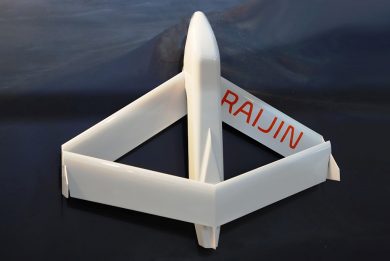SOFINS 2025 – Hitting precisely at 50 km with a 50kg ordnance and at low cost: the IGB 50 stealth Glide Bomb by the French-German Research Institute of Saint-Louis
Delivering a precision strike at 50km range is normally the job of guided artillery rockets or specifically guided 155 mm artillery rounds. While their precision strike capabilities come at considerable cost, they lack the ability to hunt down targets on the move. The French-German Research Institute of Saint-Louis, ISL in short, has developed a glide bomb that meets the need, especially for arming UAVs
Exploiting the platform flying level and the bomb glide ratio, it is possible to deliver the lethal package at a distance without needing to launch at high speed and with extremely high accelerations from a gun barrel. Exploiting this concept, ISL has developed the IGB 50, for ISL Glide Bomb, 50 being the mass of the weapon in kilogrammes.
The aim was to deliver on a target a similar lethal effect as a 155 mm artillery shell within a very reduced CEP, under 1 metre. For ISL scientists and engineers involved in the IGB 50 development the cost of the system when produced should be comparable to that of a rocket-assisted artillery shell with a course correction fuse.
The IGB 50 has an aerodynamic body with unfolding swept wings and cruciform tail; it is made of composite materiel with a shape conceived not only for providing a better than 5:1 glide ratio, but also for reducing its radar cross section when seen from the bottom and from the front. In addition to long range and stealthiness, the IGB 50 quickly reaches its target with speeds of up to Mach 0.5.
The connector on top of the fuselage allows the glide bomb to receive target grid data from the carrier platform, which can easily be a tactical UAV with a 50-60 kg payload capacity, considering the ordnance mass. The initial navigation is done following GNSS guidance; to increase resistance against jamming and spoofing, ISL has adopted a purposely developed Controlled Radiation Pattern Antenna (CRPA), which adapts dynamically in response to jamming or spoofing signals by forming nulls in the direction of the interference, thus limiting the detrimental effects of enemy navigation warfare systems on the ground. An inertial navigation platform is of course part of the navigation system and replaces GNSS inputs if these become unavailable.
ISL has also added on-board artificial intelligence (AI). Terminal guidance is based on images, an optical sensor being visible at the front. EDR On-Line understood that AI algorithms embedded in the terminal guidance software allow the IGB 50 to find its target even if it has moved from its original coordinates or performs evasive manoeuvres.
The cruciform tail actuators are used not only to direct the bomb towards its target; the IGB 50 can also be instructed to attack the target from any preferred direction, avoiding obstacles around it, the attack angle being also variable, from side to top attack, the latter option being visible in the following video.
EDR On-Line understood that ISL is working with a European company on the industrialisation of an even smaller glide bomb version. The work on the IGB 50 project at ISL is on-going with the objective of adding further capabilities, such as target engagement at a specific time and swarm attack.
Video courtesy ISL, photos courtesy ISL and P. Valpolini




